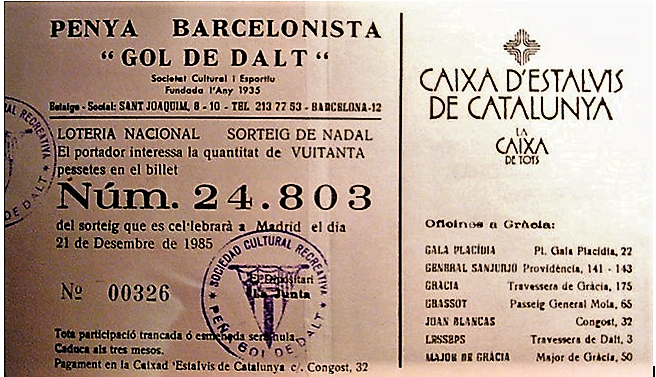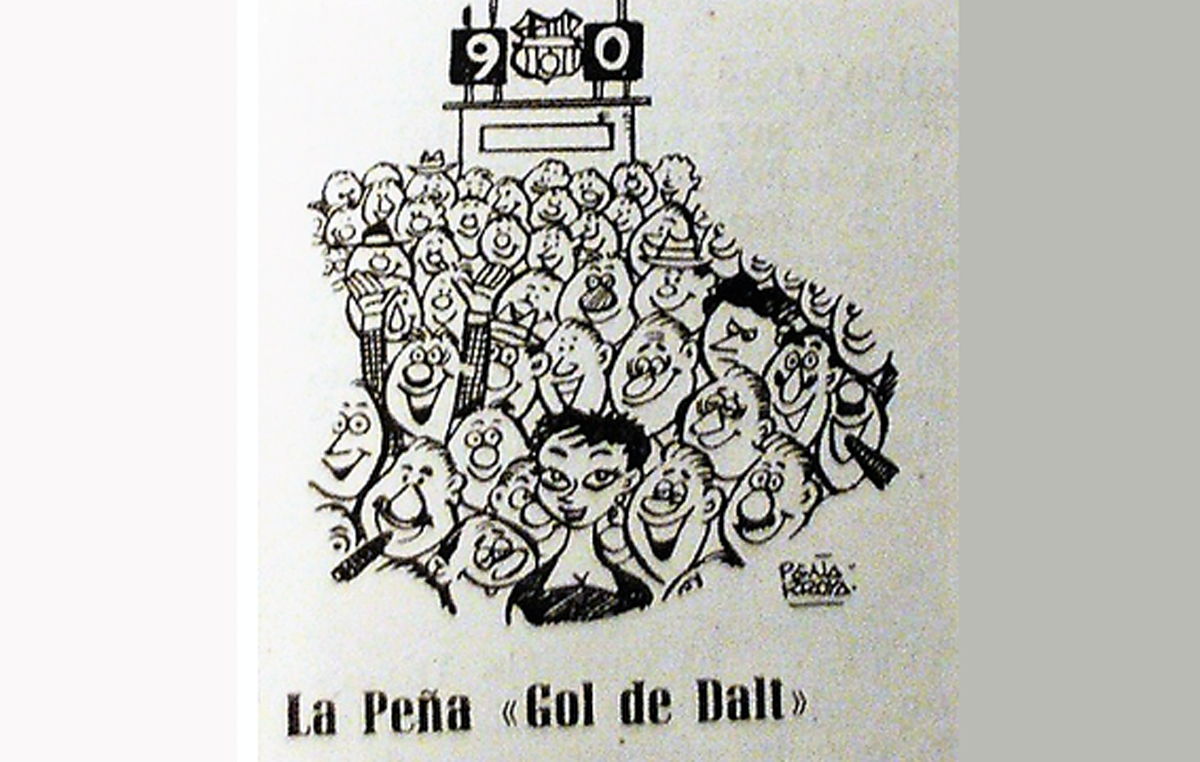If there is a penya that deserves a wider mention and to be highlighted above the rest, this is the Penya Gol de Dalt, official in the 30s but which is said to have already had activity in the times of the pitch in Industria street. The great feature that distinguishes this penya from the others is simply that it became official in 1935 and was deregistered in 2014: nothing more and nothing less than 79 years of existence that make it, so far, the longest-lived penya in the history of FC Barcelona. Of the currently active and official supporters’ clubs, only the one from Castellar del Vallès, founded in 1952, comes close.
The Penya Gol de Dalt appears in the press on June 21, 1935 in El Mundo Deportivo, where it is reported that it would play a friendly match two days later at the Les Corts pitch against the Centro Excursionista. It can be concluded that it was a very well-regarded penya within the Club, as evidenced by the fact of being able to play on the same stage where FC Barcelona’s top players played every week.
Years later, it appears in La Vanguardia of March 19, 1965, which explains the celebration of the 30th anniversary of the supporters’ club. This would include, among other things, an exhibition of the Photography Association of Catalunya in the penya’s own premises, where the first photographic competition was also organized, with prizes included.
A very avant-garde supporters’ club
In the Revista Barcelonista of July 15, 1969, this supporters’ club also appears in an extensive report explaining that it was officially founded on March 24, 1935. However, the text clarifies that this penya had already been founded, unofficially we suppose, by former members of the Club when they still played in the pitch of Industria Street. And already in 1965, there is a piece of information that surprises for its novelty: in addition to football, the Penya Gol de Dalt stood out in activities such as hiking, climbing and caving. And pay attention to its avant-gardism, because one of its projects was to try to achieve the merger of all the penyes located in the neighborhood of Gracia to later create the Casal Barcelonista de Gracia, which would be the headquarters of all the Barça fans of the historic town of Barcelona.
They end up adding that they would also need “a little help” from FC Barcelona to develop their projects, since the penya had more than 10,000 members. It is clear, then, that the message that has always been sent to the Club’s directors asking for the recognition of the supporters’ clubs as Barcelona embassies is not an invention of the 21st century, but already existed many years ago. The problem has always been the mistrust towards a movement that, above all, defends FC Barcelona in an altruistic way.
The report gives us a list of the Board of Directors of that 30th birthday. It is headed by the president, Ginés Santiago Campillo, followed by ten more directors of whom it says that “many of them defended the glorious colors of the club in the times of Bru, Reguero, Coma, Torralba, Sancho, Samitier, Vinyals, Piera, Sesúmaga, Lakatos, Martínez, Alcántara, Sagi, Blanco, Gracia, Garchitorena, Hormeu, Rodri, etc.”

Many references
The latter reference leaves one stunned, especially by the names of Lluís Bru, Reguero and Garchitorena. The great goalkeeper Lluís Bru played his last official match for Barça just 13 days before the legendary Ricardo Zamora joined the club, on May 18, 1919. On October 19 of that year, FC Barcelona organized a tribute to both him and Reguero. As for Garchitorena, to whom we dedicate a section in the book “Barça and Catalonia, the Origins of Symbiosis”, he played his last official match on the same day as Lluís Bru.
We are also struck by the fact that Salvador Hormeu is mentioned. According to the Great Dictionary of Barça Players, he is the first player from the Girona region to play for Barça, between 1914 and 1918. As for Rodri, we suppose that he refers to a second-tier player who was part of the Barça squad between 1916 and 1922, and about whom there is not much information.
And if we make a leap back in time and we look at a short gazette that appears in the publication El Diluvio of July 16, 1932, we read that “the Penya Gol de Dalt has been formed by a group of fans”. It even mentions its address at 10, Hospital Street, and makes itself available to the other supporters’ clubs to organize soccer matches.
A foundation full of mystery
So, was the Penya Gol de Dalt founded in 1935 or 1932? Or perhaps they already existed before the Club made a Barça supporters’ club official for the first time in 1919? Until more documentation is found, it will remain as one of many mysteries that still hides the history of FC Barcelona. Finally, in the official census of the 2009 Consultative Council Delegate elections, this supporters’ club still appears as active until 2014, when it disappeared. What a coincidence: just a year after all the federations of penyes were made official, that is, their great project of an entity that grouped all the supporters’ clubs in that area was fulfilled.
This was the end of the only Barça supporters’ club that survived the Civil War and the entire Franco dictatorship; that in sporting terms has lived through the Barça Golden Age, the Cinc Copes, the construction of Camp Nou, the Barça of Montal, the Dream Team, the Centenary of the Club and the entire Guardiola Era. A total of 79 years according to some publications, 82 according to others, and more than 90 if we take into account the unwritten information that has been passed down from generation to generation.






